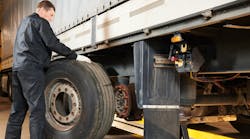Vehicles have been producing data for decades. The first on-board computers date back to the 1960s with Volkswagen’s electronic fuel injection system, manufactured by Bosch. Early on-board diagnostics (OBD), however, provided limited data, and there was no standard between vehicle manufacturers for the type of connector used, if there was a connector at all. Some OBD systems used the malfunction indicator light (MIL), flashing it in certain patterns to communicate trouble codes. This made accessing vehicle data difficult, especially for the aftermarket.
Starting with the 1996 model year, all passenger vehicles were required to use OBD-II, which specifies the 16-pin connector defined by the SAE J1962 standard that is still required on all passenger vehicles today.
The OBD connection for heavy duty commercial vehicles has gone through a similar, though somewhat more complicated, revolution. It was an OEM free-for-all when it came to connectors in pre-1996 trucks. Starting with the 1996 model year, SAE J1939, the round, 6-pin Deutsch connector, became standard. In 2001, many OEMs started using the 9-pin J1939 connector, though some continued to use the 6-pin. Since 2010, heavy duty trucks are allowed to use either J1939 (round) connectors, or J1962 (passenger car) connectors, though most continue to use the former.
Despite the changes and variances in connection ports, having a standardized way to plug in was a significant advancement when it comes to accessing a vehicle’s onboard data. It has allowed fleets to more efficiently diagnose and correct vehicle issues, which became especially important with the enhanced emissions requirements - and consequently more complex vehicle systems - of the past decade.
Cutting the cord
The next logical step in accessing vehicle data, and the most recent advancement, is to go the way of most modern technologies: wireless. While basic global positioning system (GPS) tracking has been available to fleets since the early 2000s, remote access to more comprehensive vehicle data is a more recent innovation.
Hans Molin, director of driver assist and automated driving for Bendix Commercial Vehicle Systems, says the way he sees it, there are three categories of vehicle connectivity: fleet management, safety monitoring, and remote diagnostics.
Bendix develops active safety technologies, energy management solutions, and air brake charging and control systems and components for medium duty and heavy duty trucks, tractors, trailers, buses, and other commercial vehicles throughout North America.
Breaking it down into those three categories - fleet management, safety monitoring, and remote diagnostics - there are different sensors and technologies used to gather each type of information and send it back to the fleet’s data center, and different purposes for the data itself. The actual connection - how the data is sent from the truck to the fleet - uses either satellite (GPS) or mobile broadband, the same cellular connection smartphones use. The data is typically sent from the vehicle to cloud storage, where it is maintained (and sometimes processed) and made available to the fleet.
Fleet management
Tracking a fleet’s asset locations is accomplished through the use of GPS receivers connected to trailers and/or vehicles. Most newer vehicles have some sort of GPS sensor built in from the factory, and with the recently enforced electronic logging device (ELD) mandate, virtually all heavy duty vehicles, new or old, now use some form of GPS sensor.
GPS receivers can also be attached to trailers, but since trailers do not typically generate their own power when disconnected from a truck, a power source such as a battery or solar array is necessary.
Each fleet can collect different data points from vehicles based on their needs. Most fleets, for instance, want to keep tabs on each asset’s location. This can be useful for tracking a shipment to see if it will arrive at its destination on time, knowing what vehicles will be available when, seeing how many trailers are currently parked (and where), routing vehicles around inclement weather, and even tracking fuel economy or idle time on certain routes.
“Fleet managers can improve asset utilization by keeping track of vehicles with GPS tracking and geo-fencing capability,” says Beth Leverton, global consumer marketing manager and account product owner for Ford Commercial Services. “Additionally, monitoring the fuel consumption of all vehicles identifies areas of waste and their cause, which allows fleet managers to optimize running costs.”
Ford Commercial Services is a branch of Ford Motor Co. that provides telematics and data tools for fleets.
Having this information available can help fleet dispatchers decide which vehicles should be deployed on what routes, and when, for optimal fleet efficiency.
“Fleet management software leveraging telematics and GPS tracking communicates back to a central fleet manager’s platform, including information about road conditions and vehicle utilization for the manager to make dispatch decisions,” says Kevin Aries, global product management and product success lead at Verizon Connect, a fleet management software and solutions provider.
Safety monitoring
When it comes to safety monitoring, the necessary equipment depends on the safety aspects actually being monitored. GPS can be used to track vehicle speed; cameras can be used to track driver attentiveness, driving behavior, and exterior conditions such as weather, animals, pedestrians, and other vehicles; lane departure sensors can detect erratic driving.
It is important for fleets to ensure drivers consistently engage in safe driving practices, and connected vehicle technologies can help monitor that.
“If you have a connected vehicle but add a device like a dash cam, that will enhance the data and experience,” says Brendan Keegan, CEO of national fleet management company Merchants Fleet.
Dash cameras can be used facing inside the vehicle to monitor driver behavior, outside the vehicle to monitor exterior conditions, or both. This can help fleets reinforce positive driving habits and encourage drivers to improve negative ones.
Other vehicle systems can report more detailed driver behavior data such as acceleration and braking, notes Jason Krajewski, director, truck connectivity for Detroit Connect, the telematics arm of Daimler Trucks North America’s (DTNA) Detroit Diesel.
“Today’s connected vehicle broadcasts a variety of data such as engine hours, braking severity, load factor, and transmission top gear time that helps fleets understand how vehicles are being operated, identify trends across the fleet, and determine which serviceable parts or systems they would like to develop a solution for,” Krajewski says. “Fleet service managers can utilize telematics data to determine when a unit is not being operated optimally and can use that information to help encourage good driving behaviors or identify trends that are negatively impacting service intervals. If a service manager finds a driver is not utilizing adaptive cruise control as much as they could, they will also see an increase in the wear on brake pads which will result in more frequent brake service.”
In cases such as these, the data provided by the connected vehicle can help the fleet monitor both driver behavior and vehicle maintenance.
Remote diagnostics
Where safety monitoring typically uses cameras and different types of sensors, diagnostic information is largely generated by vehicle systems themselves. System data, including any diagnostic trouble codes (DTCs), can be constantly streamed, depending on the fleet’s desired reporting requirements. This data is transmitted via cellular connection, with many OEMs offering communication technologies as a specification when fleets order new vehicles.
For example, Ford’s Leverton says integrated telematics modem technology is available across Ford’s entire lineup of commercial vehicles starting with the 2020 model year.
From the vehicle, data is typically uploaded to the cloud where it can be accessed by the fleet. Once the fleet has access to remote diagnostics data from each vehicle, it can have a tremendous impact on their maintenance operation. For example, if a vehicle system has an issue which generates a DTC, that data is immediately sent back to the fleet to alert the proper authority that the vehicle requires service.
But Bendix’s Molin says that is just the beginning. Having the DTC codes available remotely - almost instantaneously - allows for proactive maintenance. For example, if an alert comes in that a truck has a system warning, the fleet manager can look at past trends with that system on other trucks in the fleet and estimate how many miles the driver can safely continue without a system failure. If the truck can be routed to a repair facility near its next scheduled stop, an appointment can be made in advance. The truck can be repaired while the driver takes a mandatory rest period, and both can be back on the road with practically no time lost.
The type of proactive repair Molin describes can save a truck from having to make an unscheduled stop, or worse - being stranded on the side of the road with a system failure. But where reactive maintenance is good and proactive maintenance is better, predictive and prescriptive maintenance practices are best. Over time, fleets can learn to predict system failures before they happen and prescribe recommended actions, eliminating unexpected downtime.
“[We’re] moving from a fix-as-fail to a fix-as-notified mentality, thus saving costly breakdowns and increasing utilization while moving to a virtually proactive schedule-based maintenance program,” says Gerry Mead, executive director of innovation for Phillips Industries. “Utilizing machine learning to provide prescriptive maintenance solutions allows for a better upfront total cost of ownership benchmark when making a purchasing and specification decision.”
Phillips Industries is a manufacturer of electrical and air brake system components, as well as electronic solutions for communicating vehicle data to fleets and their drivers for the commercial truck and trailer industry.
For proactive, predictive, and prescriptive maintenance to truly work, fleets must properly manage the seemingly overwhelming amounts of data each vehicle can provide.
“Using telematics data to evaluate a fleet’s performance might seem straightforward, but with the amount of data collected from the vehicles it can be time-consuming to gather and sort through all the information,” Detroit Connect’s Krajewski says. “Fleets are beginning to see the value in pre-analyzed trip-by-trip drive behavior, especially when provided with simplified explanations of how the truck has been driven and where there are opportunities for improvement.”
Most telematics providers offer services to handle the data for fleets, so the fleet only needs to receive a notification when action is required.
“Important telemetry and engine data from a vehicle or asset are gathered by a tracking unit and sent back to a cloud database, often using a cellular connection,” says Reza Hemmati, vice president of product management for vehicle intelligence company Spireon.
The data collected from each asset is gathered and stored in a cloud-based application. Algorithms set by the telematics provider take this data and present a visual dashboard with alerts and reporting tools uniquely designed based on the fleet's business objectives. These objectives can be centered around improving driver behavior, optimizing daily operations, or lowering maintenance expenses.
As data is gathered and collected, provider systems can analyze the data to begin supplying prescriptive maintenance solutions in real time. A fleet can be notified by the provider before a vehicle needs service. This more hands-off approach may suit larger fleets where tracking and analyzing the enormous amounts of data produced by their vehicles is not possible in-house. Additionally, diagnostics companies such as Noregon can provide some repairs remotely.
“Consider our TripVision Uptime product: our service tells you in real time – either in the portal or via email and text notifications – when vehicles need attention to reduce unexpected breakdowns,” says Dave Covington, chief technology officer for Noregon, an internet of things (IoT) company specializing in connected vehicle solutions.
Covington says having this knowledge, along with Noregon's configurable action plans, helps fleet managers and vehicle owners avoid downtime by detecting issues before they escalate. It also includes remote functions such as diesel particulate filter regenerations (DPF regens), which previously required a shop visit, mobile repair service, or tow to a repair facility.
Other remote programming capabilities some telematics providers offer are the ability to update vehicle software, and even make parameter changes. This allows fleets to provide vehicles with over-the-air service if, for example, an OEM releases an important software update. Instead of having to wait until the vehicle is in for service or back at home base, the update can be completed while the vehicle is still on the road.
“Fleets can perform over-the-air parameter changes on one or more trucks and download Detroit Diesel Electronic Control reports without having to physically connect to the vehicle,” says Detroit Connect’s Krajewski. “Detroit Connect Remote Updates will also soon be able to perform firmware updates over the air.”
Security concerns
These newer vehicle technology do have one unfortunate consequence, however.
“Data hacking and people being able to take control of vehicles remotely are key concerns,” Merchants Fleet’s Keegan says.
Adding remote access to vehicles creates another potential entry point for hackers and other people with nefarious intent to tamper with the vehicles.
“More components or devices on a truck means an increase in threat vectors, or areas that can potentially be attacked,” Noregon’s Covington says. “Years back if you wanted to do harm to a vehicle you had to be in its physical vicinity. Now, people with malicious intent can theoretically inflict the same - or worse - damage from afar.”
Complicating the matter is the fact that vehicles may have more than one type of remote connection. With multiple entry points, it becomes more difficult to secure the vehicle’s systems against attacks.
“Connected vehicles may communicate real time within a complex system of traffic system sensors, fleet operations computers, databases of regulation and enforcement authorities, and even the driver’s personal cell phone,” says Mark Zachos, president of DG Technologies. “Any one of these vehicle communications connections could have a security risk. Also … criminal hackers are constantly probing the system for weaknesses, looking for ways to attack.”
DG Technologies specializes in the design and development of intelligent software and hardware interfaces for the in-vehicle and controller area network markets.
Hackers could take control of vehicle data or the vehicle itself in a ransom situation, making data inaccessible until demands are met.
Add to that, if a hacker is able to access a vehicle’s systems through one of these avenues, the consequences could be many. They could take control of vehicle systems in a ransom situation, making the vehicle inoperable or, worse yet, uncontrollable, until demands are met. If steering or braking systems are accessed, it could lead to catastrophic consequences for the driver and others on the road.
Protecting connected vehicles
Fortunately, OEMs and service providers are already taking steps to secure vehicles against these types of attacks.
“Most vehicle manufacturers and component suppliers are already upping their game by following industry best cybersecurity practices in their new designs,” Zachos says. “The adoption of standard security practices - such as SAE J3061 for engineering processes - and incorporating secure software upgrade procedures to patch newly discovered vulnerabilities have already made new equipment more secure.”
Detroit Connect’s Krajewski confirms that DTNA employs multiple layers of security measures to keep customer vehicle data secure. He says the company is also constantly exploring data security measures, and frequently participates in breach testing within its own fleet to ensure there are no vulnerabilities that can be easily exploited.
There are also steps fleets should take to ensure the security of their connected vehicles and associated data. Krajewski says one thing users can do to protect themselves is to regularly review who has access to their data and vehicles.
“As the fleet or vehicle owner, you should partner with proven, reputable companies and organizations you trust to properly manage the devices on your trucks,” Covington adds. “Ask about their security processes and ensure they align with your own company’s [processes]. Device and component manufacturers must ensure they protect and limit access to the vehicle by applying technologies such as virtual private network [VPN] tunneling, encrypted protocols, or additional methods that will mitigate the risks associated with an open, easily accessible network.”
Covington also notes that it’s a good idea to have an understanding of what components are supposed to be on the vehicle, and to train technicians to be vigilant if something seems odd.
“Use an in-shop diagnostic and repair solution like JPRO Professional that automatically identifies all components on the vehicle and look for components that do not belong on the truck,” he says. “Additionally, keep your software versioning on ECUs up to date so you have any recent patches released by the manufacturer.”
Businesses today make great efforts to protect their systems from cyber attacks. Fleets should give as much thought and attention to how they protect their vehicle and shop systems to minimize the risk of unauthorized access that could lead to detrimental damage.
Phillips’ Mead offers three steps fleets can take to protect their vehicles and systems against hacking:
- Update your operating system (OS) and other software frequently, if not automatically.
- Ensure you have up-to-date security programs.
- Password protect all of your devices.
Verizon Connect’s Aries adds that fleets should also learn to embrace encryption and multi-factor authentication, and - as anyone should in today’s world - be leery of suspicious emails.
Through the firewall
One concern fleets and repair shops may have is that having security measures in place on vehicles will limit or restrict technician access to vehicle systems for diagnosis and repair. But while it does restrict who can access vehicle systems, it’s not unreasonably so. It won’t prevent those who need access from gaining it, and the industry seems to be understanding of this necessity.
“You’re going to have to go through the right channels,” Bendix’s Molin says. “You will have to certify that the tool you're trying to connect with is a valid, certified tool. But I think anyone in the industry wouldn't have an issue with that. We talk a lot with technicians, with shops ... I think that the industry understands that doing this properly and making sure that it's not the ‘Wild West’ out there is in everyone's interest.”
Covington confirms it should not be a burden for a technician to diagnose and repair a connected vehicle, but fleets should take steps to ensure only the people who need access to the various components on a vehicle are allowed access.
“This could require a call into a dealership or OE to be granted permission, some form of two-factor authentication to prove the technician making modifications is authorized to do so, or other security measures that are effective but don’t require much of the technician’s time to do so,” he says.
Planning for the future
Connected vehicles offer a lot of potential moving forward. While today’s vehicles can connect to GPS and the cloud, development is underway for vehicle-to-vehicle (V2V) and vehicle-to-infrastructure (V2I) communication, paving the way for vehicle-to-everything (V2X) communication. These capabilities could help bring about efficiencies such as platooning and automated vehicles.
“As V2V and V2X communication develops, additional vehicle and object awareness can enhance and provide additional safety for drivers,” Merchants Fleet’s Keegan says.
Companies such as Bendix are already testing V2V technologies in platooning pilots. Platooning allows trucks to drive very close together, one behind the other. The lead truck breaks the wind resistance for the following trucks, offering them improved efficiency.
“The typical example right now is the pilots we do with platooning,” Bendix’s Molin says. “At that point you need direct V2V [communication], and to be able to send it out to those two vehicles in what's currently an unsafe space because they're too close to each other. You need to have a solid, solid V2V connection so that as soon as that first truck brakes ... that second truck needs to know the same millisecond to brake at the same time. We can't wait for the relative distance between the two vehicles to start to decrease before the second vehicle understands that braking is happening.”
While V2V communication may be useful for operations such as platooning, it could also help with autonomous driving. If vehicles are able to communicate, and therefore know instantaneously what the vehicles around them are doing, it will allow them to react in that instant, preventing potential mishaps.
V2I communication could also be helpful when it comes to autonomous vehicles. If an autonomous vehicle knows a traffic light is ahead, for example, it can prepare to stop depending on what the light is communicating - whether it will be red or green by the time the vehicle reaches it.
Molin notes that V2I communication may end up looking more like V2X, however. Instead of the traffic light sending a dedicated message to each individual vehicle, that information can go from the traffic light to the cloud to be used by all vehicles in the area.
Vehicle automation will make communication even more vital for vehicle maintenance. Molin explains that today, the driver monitors vehicle systems and can feel what the vehicle is doing. However, as technology gets closer to fully autonomous vehicles by augmenting the driver more and more, fleets will need to know vehicle conditions remotely.
This means that vehicle system sensors will need to become even more robust, detecting every system to ensure it is operating properly, since the driver will not be there to monitor them. Then, that information needs to be communicated back to the fleet.
Conclusion
From humble beginnings, vehicle data connections have come a long way and made vehicle maintenance more streamlined and efficient. Remotely connected vehicles are no longer a thing of the future; they are a present-day reality.
As connected vehicles launch the transportation industries into the future, it will include greater maintenance efficiency and, therefore, increased uptime.
With great power, however, comes great responsibility, and keeping vehicle connections secure needs to be priority number one for OEMs, telematics service providers, fleets, and owners alike.




